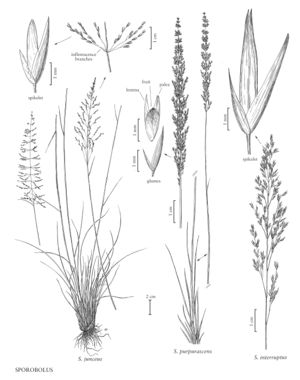Difference between revisions of "Sporobolus junceus"
FNA>Volume Importer |
FNA>Volume Importer |
||
| Line 17: | Line 17: | ||
-->{{Treatment/Body | -->{{Treatment/Body | ||
|distribution=Va.;Okla.;Miss.;Tex.;La.;Ala.;Tenn.;N.C.;S.C.;Ark.;Ga.;Ariz.;Fla. | |distribution=Va.;Okla.;Miss.;Tex.;La.;Ala.;Tenn.;N.C.;S.C.;Ark.;Ga.;Ariz.;Fla. | ||
| − | |discussion=<p | + | |discussion=<p>Sporobolus junceus grows in openings in pine and hardwood forests, coastal prairies, and pine barrens, usually in sandy to loamy soils, at 2-400 m. Its range lies entirely within the southern United States.</p> |
|tables= | |tables= | ||
|references= | |references= | ||
| Line 33: | Line 33: | ||
|basionyms= | |basionyms= | ||
|family=Poaceae | |family=Poaceae | ||
| + | |illustrator=Linda A. Vorobik and Hana Pazdírková | ||
|distribution=Va.;Okla.;Miss.;Tex.;La.;Ala.;Tenn.;N.C.;S.C.;Ark.;Ga.;Ariz.;Fla. | |distribution=Va.;Okla.;Miss.;Tex.;La.;Ala.;Tenn.;N.C.;S.C.;Ark.;Ga.;Ariz.;Fla. | ||
|reference=None | |reference=None | ||
| Line 38: | Line 39: | ||
|publication year= | |publication year= | ||
|special status= | |special status= | ||
| − | |source xml=https:// | + | |source xml=https://bibilujan@bitbucket.org/aafc-mbb/fna-data-curation.git/src/314eb390f968962f596ae85f506b4b3db8683b1b/coarse_grained_fna_xml/V25/V25_686.xml |
|subfamily=Poaceae subfam. Chloridoideae | |subfamily=Poaceae subfam. Chloridoideae | ||
|tribe=Poaceae tribe Cynodonteae | |tribe=Poaceae tribe Cynodonteae | ||
Revision as of 16:17, 30 October 2019
Plants perennial; cespitose, not rhizomatous. Culms (30)40-100 cm. Sheaths rounded below, margins and apices sometimes sparsely ciliate; ligules 0.1-0.2 mm; blades (6)10-30 cm long, 0.8-2 mm wide, flat to tightly involute, glabrous abaxially, scabridulous adaxially, margins scabrous, apices pungent. Panicles 7-28 cm long, 2-6 cm wide, open, pyramidal; lower nodes with 3 or more branches; primary branches 0.7-4.5 cm, spreading 20-100° from the rachis, whorled or verticellate, without spikelets on the lower 1/8–1/2; secondary branches appressed; pedicels 0.4-2.5 mm, appressed, scabridulous. Spikelets 2.6-3.8 mm, purplish-red. Glumes unequal, linear-lanceolate to lanceolate or ovate, hyaline to membranous; lower glumes 0.9-3 mm; upper glumes 2.6-3.8 mm, as long as or longer than the florets; lemmas 2-3.6 mm, ovate, membranous, glabrous, acute; paleas 2-3.6 mm, ovate, membranous; anthers 1.4-2 mm, purplish. Fruits 1.4-1.8 mm, ellipsoid, somewhat laterally flattened, somewhat rugulose, reddish-brown. 2n = unknown.
Distribution
Va., Okla., Miss., Tex., La., Ala., Tenn., N.C., S.C., Ark., Ga., Ariz., Fla.
Discussion
Sporobolus junceus grows in openings in pine and hardwood forests, coastal prairies, and pine barrens, usually in sandy to loamy soils, at 2-400 m. Its range lies entirely within the southern United States.
Selected References
None.
